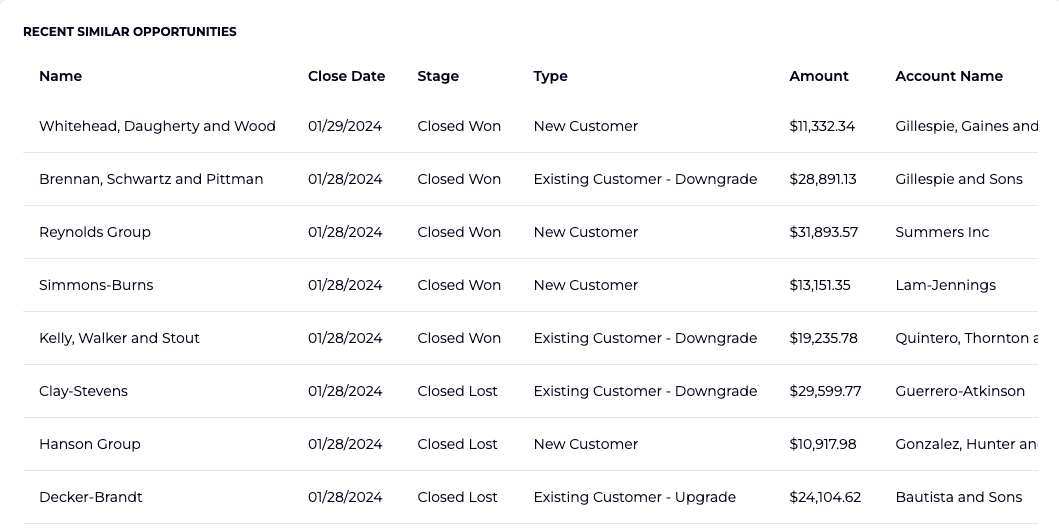Opportunities
Summary
The purpose of this guide is to help you understand how the opportunity object is used in OpenGTM. While opportunities in OpenGTM can be use in many ways including B2C (business to consumer) and B2B (business to business) models, they are treated as deals with a dollar amount and expected transaction date that sales professionals are tracking towards. If your business model doesn't seem to fit the ideas presented here, don't hesitate to schedule time with one of our product experts to get additional guidance. Also, review Things to Consider to understand minimum data requirements.
Opportunity Creation
It's important that marketing and sales define together when an opportunity should be created. Opportunities serve as the backbone for all revenue forecasting in a business. The fields on an opportunity should be kept up to date as the deal progresses, especially critical fields like the close date and amount. It is common for opportunities to be created when a lead is converted, which commonly occurs when a sales or business development professional determines if your solution fits the problem the contact is looking to solve, and if their timeline and budget fit the expectations of your business. The opportunity created date will be used to determine how long opportunities were open to help predict a close date for open opportunities.
Opportunity Types
The opportunity type field in OpenGTM can be used to separate different types of opportunities like new customer, upgrade, and renewal opportunities. The type filter on the dashboard and record list pages will show the distinct types set on opportunities be synced from the CRM. This allows you to understand the composition of opportunities across teams like marketing, sales, and customer success. The manager hierarchy can also help here (see Manage Team). OpenGTM recommends syncing all new customer, upgrade, and renewal opportunities to best inform what a great customer and repeat buyer looks like for your business to create an optimal deal prioritization engine, but this isn't required. For example, only syncing new customer opportunities will still help you understand and prioritize those prospects and deals with the attributes that your business is winning continuously.
Repeat Buyer Personas
After syncing and analyzing closed opportunities from the CRM, Repeat Buyer Personas will be generated. Repeat Buyer Personas are found by identifying groupings in the won opportunities and the attributes most important to each grouping. A fake first and last name, company name, headshot, and company icon along with the grouping's most important attributes are presented in a persona card format for readability and regular reference. These personas will show the attributes of what a best customer and repeat buyer will look like, and form the foundation of the opportunity scoring mechanism. Sales professionals can use these Repeat Buyer Personas to get a clear picture of what deals to focus their efforts on, which deals to eject from, and which deals may need additional nuturing from marketing. The full analysis is made available under the details tab.
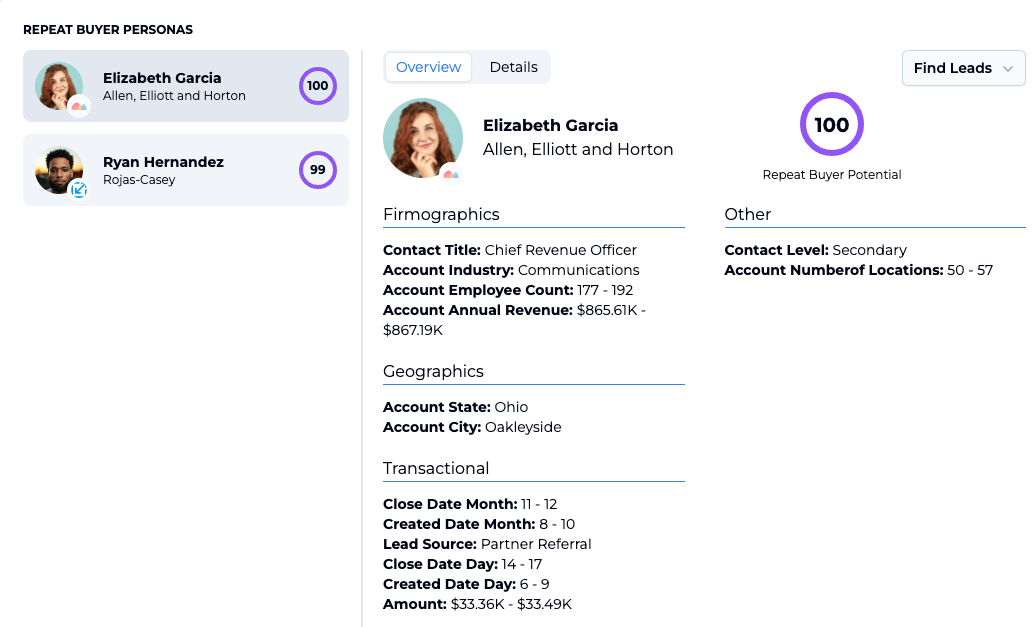
Find Leads
You can easily use your Repeat Buyer Personas to find leads in both Seamless and Apollo using the find leads button drop down. We use as many of the top attributes found on the Repeat Buyer Persona card and some others in the full analsis and map them to the Filters in Seamless and Apollo to find leads that closely align to the persona quickly.
Recent Aligned Records
The recent aligned records component, below the Repeat Buyer Persona attributes allows you to see a sample of recently won opportunites that are apart of this persona's grouping. All opportunity types synced from the CRM can show here. You can use this to validate the analysis, find examples of opportunites in this persona, and experiment with field mappings. For example, you notice that a few opportunites don't really make sense as apart of this persona, and you realize that there may be fields missing in the field mappings to identify the difference between these opportunites. After updating the field mappings, you see a new persona to represent this new combination of attributes with the list of opportunites you expects to see together. Keep is mind that while this very simple example can happen, the Persona Engine is using a number of machine learning techniques to spot patterns in your won opportunites not possible to spot with the human eye. If you have concerns about what opportunites are showing here, don't hesitate to reach out to support.
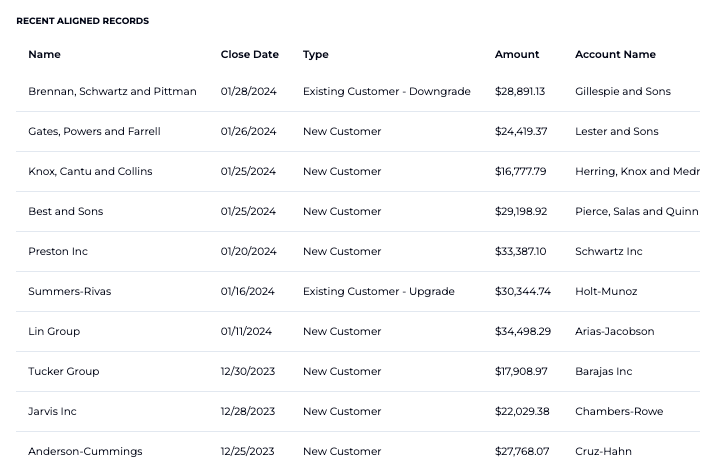
Opportunity Scoring
Once Repeat Buyer Personas are generated, each open opportunity is scored based on how closely aligned the opportunity is to the top scoring attributes for each of the team's Repeat Buyer Personas. The best score is taken and these scores serve as important indicators to help sales, customer success, and marketing professionals prioritize which opportunities to focus their efforts on.
This method differs greatly from the traditional approach taked by most CRM and engagement solutions, where linear logistic regression probability serves as the basis for scoring. This method identifies key groupings in your won opportunites and the attributes most important to those groupings, and determines how closely aligned open opportunites are to these groupings and their top scoring attributes. Inherently, this difference has a unique advantage over traditional methods increasing the accuracy of opportunity scores. If upgrade and renewal opportunities are included potential customer lifetime value will be factored into the scores.
The opportunities list allows you to quickly prioritize open opportunities with the most repeat buyer potential. Additional sorting can be done by selecting a column name once to ascend and twice to descend by that column's values. Currently, filtering by territory, type, and reporting level are available. Fields in the list include: Name, Amount, Stage, Close Date, Repeat Buyer Potential, Win Potential, and Forecast Category.
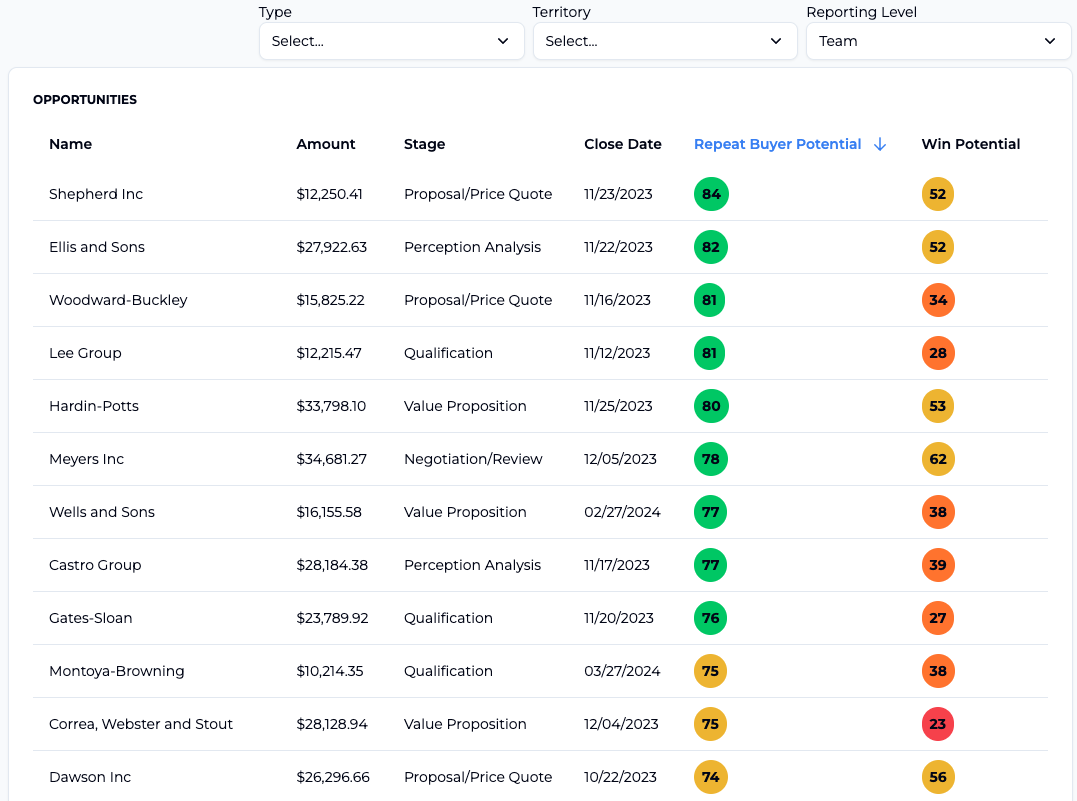
Opportunity Territory
The territory filter on the dashboard and opportunities list pages will show the distinct territories set on opportunities synced from the CRM. This allows you to understand the composition of opportunities across territories. If the territory field is not mapped in the fields mappings or if all opportunites are missing a value then the territory filter will not show. If you just accept the field mapping defaults then the territory filter will not show.
Opportunity Detail
The opportunity detail page can be found by selecting an opportunites name in both the quick wins list and the opportunities list. This page will show a list of key CRM fields and values we have received from the CRM along with other analysises and predictions completed for each open opportunity.
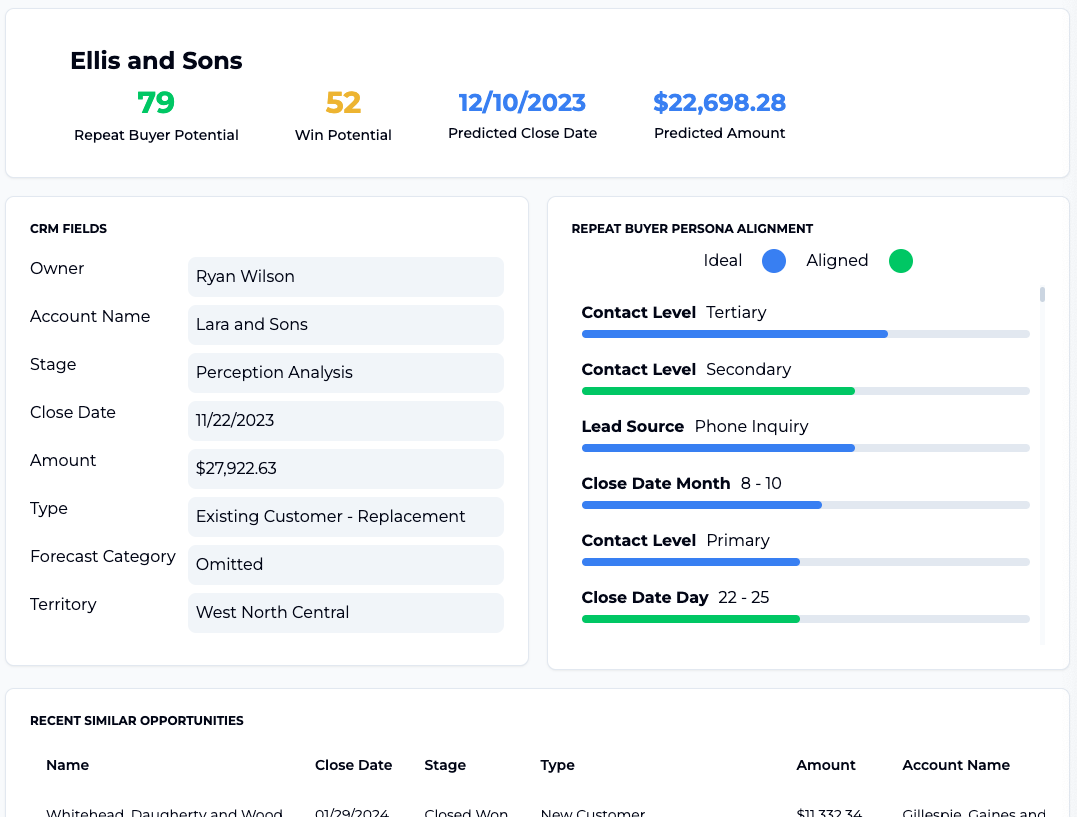
Win Potential
This score more closely aligns to the traditional methods used by CRM and engagement solutions to score opportunites and leads. The Win Potential score is a win probability score. Different from traditional methods, OpenGTM is using more modern techniques than linear logistic regression probability for separating wins and losses and determing probabilities while not being as affected by outliers.
Predicted Close Date
For each open opportunity a predicted close date is generated. This date is predicated using a calculation for days open, which takes the difference between the close date and the created date. Closed opportunities are analyzed using machine learning to predict the days open opportunities will be open for.
Predicted Amount
For each open opportunity a predicted amount is generated by analyzing closed opportunites to identify patterns that can be used to determine what the amount will be when the opportunity closes. The predicted amount can be compared to the CRM amount to determine if you may be leaving money on the table or if a price decrease may make sense. The list of recent similar opportunites can be helpful in determining this.
Repeat Buyer Persona Alignment
The Repeat Buyer Persona alignment component on the opportunity detail page give insight into the composition of the opportunity's Repeat Buyer Potential score. The full list of attributes is shown by order of importance to the persona's grouping. The persona used here will be the persona, at the team reporting level, that this opportunity most closely aligned to. The attributes with the bar color matching Ideal in the legend are the full set of attributes and their importance that define the grouping. The attributes with the bar color matching Aligned in the legend are the attributes that this opportunity matches or aligns to. These aligned attributes scores are then used in the score process to determine the Repeat Buyer Potential of the opportunity.
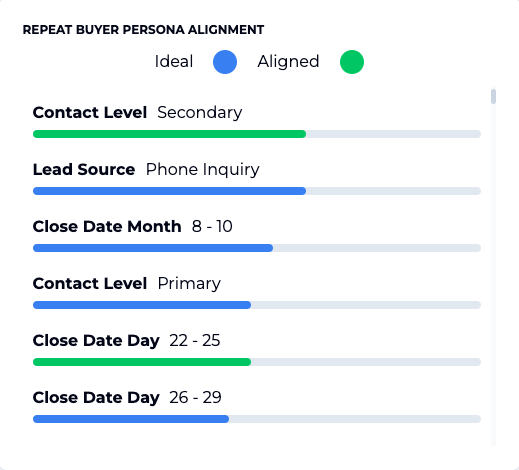
Recent Similar Opportunities
On the opportunity detail page, the recent similar opportunities component gives insight into recent similar opportunites that this opportunity is being grouped with for all machine learning predictions. This is not an exact analysis and only a sample as each prediction uses it's own set of machine learning algorithms and techniques to make predictions, but will be pretty close. Sales and customer success professionals can use wins from this list as potential reference customers to name-drop or the list of losses as a reason to emotion detach and eject from an opportunity.
